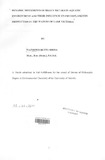| dc.description.abstract | The environmental processes physical, chemical and biological interactions at ecosystem scale, affect the Lake ecosystem including algae and invertebrates, which are food for fish. Therefore, it is logical to examine the physical, chemical, and contaminants as potentially influencing algal biomass and distribution in Lake Victoria. Examination of the physical and chemical speciation of trace mental in Nakivubo Channel and Lake Victoria waters as well as their influence on phytoplankton production will give an insight into dynamics heavy metal movement in the aquatic environment, thus leading to proper management of pollutants and the associated improvement of the Lake Victoria ecosystem.
In this thesis, each specific objective is a chapter and each chapter consists of an abstract, a brief introduction, methods and materials, results, discussions and references. Physicochemical parameters for the field samples are discussed in Chapter 1. Turbidity levels in catchments with substantial vegetation were significantly lower than those without. pH values ranging from 5.73 up to 13.90 were observed for some of the point sources. The physicochemical parameters along Nakivubo Channel waters were relatively higher than the Lake Victoria waters. Despite of differences in the physicochemical parameters in lake waters, their levels were below WHO guidelines for drinking water.
For speciation studies (chapter 2), speciation of metal ions was analyzed using magnetic technique. Whereby, the method consisted of a column of supported Dowex surrounded by movable permanent magnet. Iron species in Nakivubo and Lake Victoria waters were determined by ion exchange chromatography in chelated form by using ion exchange (Dowex I-XI8, 20-50 US mesh (CI)) enhanced by magnetic field. The results showed that iron was mostly in oxidation state +2 long the Nakivubo
Channel, while in the open lake; iron existed in +3 form.
To understand better the pollution levels in the waters of the Nakivubo Channel and Lake Victoria (chapter 3), the concentrations of manganese (Mn), iron (Fe), cobalt (Co), copper (Cu), zinc (Zn) and lead (Pb) were determined using convectional Energy Dispersive X-ray Fluorescence Analysis (EDXRF) and Total X-ray Fluorescence (TXRF) analysis. Particulate deposits were analyzed for trace metals with a convectional EDXRF spectrometer. Extracted dissolved metals and Total metal contents were analyzed with Total Reflection X-Ray Fluorescence. Cobalt and lead concentrations were below detection limits for most of the sampling sites. Generally, most metal concentrations along the Nakivubo Channel exceeded acceptable limits, illustrating the need for
mitigation measures.
The seasonal variations in biological parameter and biodiversity of planktonic life have been investigated and discussed (chapter 4). Blue-green algae (Cyanophyta) dominated the shores of lake Victoria waters constituting 54.109% as compared to the diatoms 24.435% and green algae (Chlorophyta) 14.656% , Euglenophytes and Dinoflagellates both contributing less than 10% in the algal biomass. Cyanophyta dominated the phytoplankton community in Murchison bay. The distribution of algae at Sango Bay stations, however, is different in that diatoms dominate Sango Bay stations.
The study also investigated the effluence of Fe3+, Fe2+ and Zn2+ (chapter 5) to four strains of microcystis ( CYN 464, CYN 465, CYN 478, CYN 522) isolated from Lake Victoria at Murchison Bay. The idea that iron species and zinc ions might limit phytoplankton growth in Lake Victoria waters was tested by enriching the culture medias with different metal concentrations.
The reproduction rate of the four species of Lake Victoria Phytoplankton was monitored. In general, the reproductive rates of the four microcystis strains decreased with increase in zinc concentration and iron (II) concentrations. While the growth rate of the four strains increased with increase in iron (III) concentrations. This response to different metal concentrations provides evidence that high zinc and iron (II) ion concentrations limit phytoplankton growth and species distribution. Iron (III) availability is an important selective force on Lake Victoria phytoplankton populations communities. | en_US |

